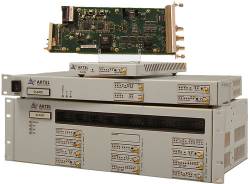Artel expands DigiLink platform in the same space
The folks at Artel Video Systems have a knack for getting the most out of the technology they offer their customers. This, said Richard Dellacanonica, the company’s president and CEO, is important to his company’s bottom line as well as to facilities that have limited equipment room space and to existing customers who want to preserve their investment and do more with what they already have. For those existing customers, Artel has added new video over IP, Ethernet transport and integrated routing capabilities to its DigiLink Video Transport platform.

“We recognize that customers don't want to throw away good technology to get more functionality,” Dellacanonica said. “With the DigiLink platform, we’re able to add more cards to existing frames in the field. That’s cost-effective for our customers and the right thing to do for the industry. We shouldn't keep re-inventing the wheel when there’s no need to.”
Dellacanonica is a veteran at developing video transport systems, starting with baseband SDI in the mid-1990s and moving to today’s video over IP applications. He said that although he can guarantee a reliable IP signal inside and output from his platform, once it leaves a facility the user is at the mercy of the available network. This has been a real concern among some broadcasters looking to move contribution-level video across the country (or around the world).
“We’re showing long-distance transmission over an IP network with 10ms to 20ms of latency,” he said. “That should be good enough for any type of video application. However, everyone’s scared to death of Ethernet because it can be difficult to ensure a reliable packet structure gets to the receive end. In all my years of working in this field, we’ve always been limited by the bottleneck of the network. If you give us a good Ethernet backbone, and they are available if you look around, we can deliver HD-quality video with low latency. No question about it. That’s pretty good, even by today’s standards.”
At the recent Content & Communications World (CCW) conference in New York, Artel Video Systems displayed a new chassis and demonstrated a series of new modules for the DigiLink Video Transport platform to meet the growing needs of broadcasters as they migrate towards IP-based infrastructures. The new DL4360x chassis integrates video and Ethernet transport capabilities with internal traffic routing. This allows technicians and network engineers to combine what has in the past been accomplished with several silo systems into a single, 3RU, ultra-low power solution.
“This eliminates the need for external cross connects and significantly simplifies routing and re-routing of video and Ethernet traffic to meet changing requirements,” Dellacanonica said.
The chassis holds up to a dozen circuit cards modules with each supporting up to 10 video services of any format — from 3G-SDI to DVB-ASI, five GigE ports, multiple 10GigE ports, or a combination of both based on the installed module.
The professional video industry's #1 source for news, trends and product and tech information. Sign up below.
The DigiLink platform now accomodates video and Ethernet transport, video routing and trunking, optical multiplexing, JPEG2000 compression, audio embedding, signal generator and circuit verification functions.
“The goal with this platform is to provide a cost-effective and truly unique solution for contribution quality video transport,” Dellacanonica said, adding that forward error correction and other signal processing algorithms have been built into the DigiLink platform to ensure a reliable contribution service.”
Artel has also announced newer versions of its HTTP and SNMP management software, which simplifies transmission system deployment while providing a comprehensive set of transport stream status and logging capabilities.
“Video delivered as packets will be commonplace in about five years,” Dellacanonica said. “We’ll be ready when the industry is. We think we have a platform with a lot of room for expansion and one that our customers can grow with as they see fit.”
Several local and international broadcasters used Artel’s video transport technology extensively during coverage of the Democratic National Convention, in Charlotte, NC, in September.
